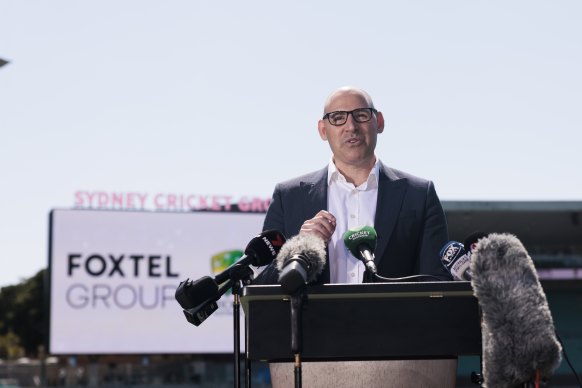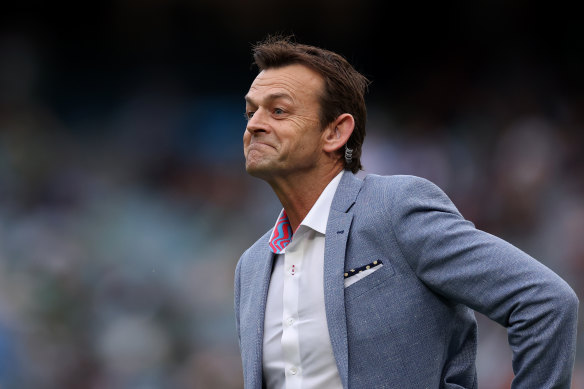Inside story: How Seven’s cricket bargain grew out of CA’s Foxtel alliance
In the days before Australia’s first Test of the summer, against the West Indies in Perth, Seven West Media held a function to ring in the start of the cricket it televised.
Attendees included Kerry Stokes and the AFL’s chair Richard Goyder, the high-powered pair who have pulled plenty of business, sport and broadcast strings from their shared base in Western Australia over recent years.
Goyder, though, does not run Cricket Australia. It was the absence of any similar representation from CA that raised eyebrows among those present, illustrating how tenuous Seven’s hold on cricket then seemed.
Nick Hockley, backed by Foxtel branding, at the SCG.Credit:Brook Mitchell
After three years of something like warfare between CA and its free-to-air broadcaster, cricket’s negotiators were actively looking elsewhere. Whether courting Paramount and Ten to coax out an initial offer of $1.5 billion, or breaking bread with Nine, publisher of this masthead, to examine how a deal might be done with cricket’s former long-time ally, change looked likely.
During the Test that followed, there was tension on the field, too. Seven’s signing of Justin Langer after his acrimonious resignation as Australia’s head coach had made for a publicity splash. His series of public hugs and handshakes with players and staff – after Seven positioned itself close enough to the action to make this possible – was cause for three-way jostling between Seven, Fox Cricket and the team over who had right of way.
Yet only a month later, Seven had re-signed as CA’s FTA partner, in league with Foxtel. It had done so at a bargain price of around $65 million a year over seven years, as opposed to $82 million a year as part of the existing $1.18 billion deal. For that discount, it also gained the rights to stream matches on Seven Plus.
Seven’s head of sport Lewis Martin, who alongside Stokes, commercial director Bruce McWilliam and chief executive James Warburton had led the campaign against cricket, was unblinking in declaring at the deal’s SCG announcement that the network had not “trashed” the summer game.
In reality, the foundation stone of this dramatic outcome had been laid at the same time as the 2018 terms were signed. Back then, CA made the strategic call to switch from an FTA partnerships model to a deep and enduring tandem: with Foxtel, News Corp and its combination of pay TV money and a vast newspaper and digital group.
Cornering the cricket market
By teaming up with Foxtel after a five-year stint where it shared the Big Bash League and international cricket between Ten and Nine, CA effectively reduced the number of networks it could negotiate with.
Why? Of the three commercial, FTA networks so critical to ensuring major sports are seen by as wide an Australian audience as possible, only Seven has not launched its own pay per view streaming arm to compete with Foxtel.
While Nine has the rights to the NRL in a conglomerate deal shared with Foxtel, the preference now is for content to be purchased and run across the linear and streaming wings of the one entity. Ten and Paramount have similar goals.
Seven, of course, complained long and loud about not getting enough of a halo effect from its cricket rights in the first two years of the deal. But it is often forgotten that Foxtel were not altogether enamoured either: Industry sources, talking on condition of anonymity so to speak frankly, have recalled how chief executive Patrick Delany declared more than once in 2019 that “cricket hasn’t worked” for Foxtel or Kayo.
CA, though, found a very useful ally in the Foxtel relationship when it nominated a new board director later that year. The former Foxtel chief executive Richard Freudenstein was not just a seasoned media player, but also a paid director of News Corp’s REA Group, and a sturdy back channel to Foxtel and News Corp in the event of further crisis. When COVID-19 hit the following year, Seven’s shrill arguing and use of the courts contrasted sharply with Fox’s calmness.
Cricket Australia broadcast deals over the past 30 years
1989-1994 (Nine) $15 million, $3m a year
1994-1999 (Nine) $55 million, $11m a year
1999-2005 (Nine) $195 million, $32.5m a year
2005-2013 (Nine) $275 million, $35m a year
2013-2018 (Nine, Ten) $590 million, $118m a year
2018-2024 (Foxtel, Seven) $1.18 billion, $197m a year
2024-2031 (Foxtel, Seven) $1.512 billion, $216m a year
Having ridden out the pandemic together in peace, while watching Kayo grow steadily into the most reliable sports streaming product in Australia, CA and Foxtel were never likely to part ways. A relationship of mutual dependence was underlined by how, in the new deal unveiled this week, Foxtel covered all of the cash uplift, about $30 million a year, to keep exclusive rights to men’s white-ball matches.
Ten-Paramount blink, Seven swoop
Even so, CA needed to create some kind of competition in the market if cricket’s administrators were to gain something even remotely close to the massive increases wrought from every broadcast deal since 1994.
Ten and Paramount were courted by CA during 2022, leading to an opening offer of $1.5 billion for the chance to take everything from Foxtel and Seven. While CA’s chief executive Nick Hockley was eager to suggest that by reaching $1.512 billion, the incumbents had also been the highest bidders, sources close to Ten and Paramount made it plain that their initial number had been just that – plenty more may easily have been on the table.
Numerous senior figures at CA were weary, and wary, of Seven. At its ugliest point in December 2020, the network’s campaign featured the airing of private conversations between Martin and CA’s head of commercial Steph Beltrame, alongside fellow senior figures Peter Roach and Alistair Dobson. This breach of trust, as part of Seven’s court action, has remained a sore point ever since.
But Paramount gave Seven and Foxtel a chance to seal a deal on their terms by indicating in mid-December that it preferred to pause talks until after the Christmas and New Year break. In addition to questions over Ten’s audience reach, negative user feedback about Paramount streaming, and the vagaries of dealing with US-based executives rather than homegrown chiefs, CA had enough reason to doubt.
Adam Gilchrist is the focal point of Fox Cricket’s coverage. Credit:Getty
At the same time, CA’s executives and directors did not go quite as far as the AFL in making a highly publicised visit to the United States to meet Paramount’s heavies in person. And without the genuine prospect of CA walking away from Foxtel, the only conversations left to be had were those at cross purposes.
The Olympics change hands
Neither Ten, nor Nine, were interested in playing the role of Seven alongside Foxtel. The preference for networks other than Seven is to have complete ownership of a sport, the better to share it between FTA and streaming.
Four weeks after the Stokes and Goyder cocktail party in Perth, Nine’s decision to pay $300 million to wrest the Olympics from its traditional home at Seven was another instance of that strategy playing out. Warburton, in an all-staff email, couched this as a decision to “liberate” the network from its long axis with the IOC.
That left Seven as the only network with both the money and the strategic desire to buy back into cricket alongside Foxtel. With the Nine pot committed elsewhere, and Paramount not only bullied off the ball but also on holidays, CA was left to make the only decision it could make, to keep its incumbents for an annual fee that, at $216 million versus $197 million, barely covers inflation.
As in 2018, the consequences of CA’s decision will not be fully known until the new deal has run far more of its course. The terms of five years ago, signed amid the hype of the Gold Coast Commonwealth Games, set up a period of enormous instability at the hands of Seven’s powerbrokers.
This time around, a minimal increase in rights value, on favourable terms to Foxtel and Seven, may become known as the bargain that pushed CA into the great unknown of privatisation.
Most Viewed in Sport
From our partners
Source: Read Full Article


